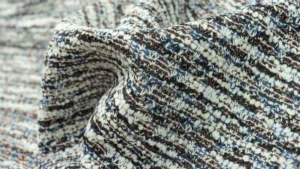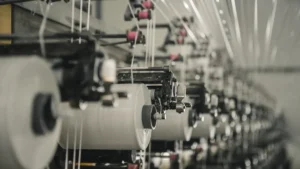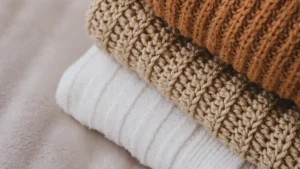
Double knit yarn, also known as DK or double knitting yarn, is a popular type of lightweight yarn. If you’re wondering what weight is double knit yarn, the Craft Yarn Council classifies it as Category 3, which is considered a light or medium weight yarn. Typically, double knit yarn consists of 8 plies twisted together, making it thinner than worsted yarn but thicker than sport yarn. Many crafters prefer using DK yarn for double knitting projects due to its versatile weight and texture.
Here are some key features to help you understand what weight is double knit yarn:
Characteristic | Description/Range |
|---|---|
Yarn Weight Category | Medium weight (CYC Category 3 – Light) |
Gauge | 21-24 stitches per 4 inches (10 cm) |
Recommended Needle Size | US 5 to 7 (3.75-4.5 mm) |
Recommended Hook Size | US 7 to I-9 (4.5-5.5 mm) |
Wraps Per Inch (WPI) | 11-15 |
Thickness Comparison | Thinner than worsted, thicker than sport |
Whether you’re double knitting or working on other projects, knowing what weight is double knit yarn can help you choose the right yarn for your needs.
Key Takeaways
Double knit (DK) yarn is a light to medium weight yarn, classified as Category 3 by the Craft Yarn Council.
DK yarn is thicker than sport yarn but thinner than worsted yarn, usually with 8 plies and 11-15 wraps per inch.
Recommended needle sizes for DK yarn are US 5 to 7 (3.75-4.5 mm), with a typical gauge of 21-24 stitches per 4 inches.
You can identify DK yarn by reading the label, measuring wraps per inch, or knitting a gauge swatch to check stitch count.
DK yarn is versatile and great for sweaters, baby clothes, hats, scarves, and amigurumi, making it ideal for beginners and experienced crafters.
What Weight Is Double Knit Yarn

DK Yarn Overview
When you want to know what weight is double knit yarn, you need to look at its place in the yarn world. DK yarn sits between sport and worsted yarns in terms of yarn thickness. This means you get a yarn that is not too thin and not too thick. Many crafters choose DK for its balance and versatility.
The term “double knitting” comes from a technique that creates a double-thick fabric. Over time, people started using this term to describe a specific yarn weight. In the UK and other Commonwealth countries, you may see DK yarn called “8-ply.” This name comes from the practice of holding two strands of fingering-weight yarn together to make a heavier yarn. Today, most yarn makers and crafters use DK to mean a yarn that is thicker than sport but lighter than worsted.
You will often find DK yarn in balls or skeins that weigh 50 or 100 grams. A standard 100-gram ball of DK yarn usually has between 190 and 300 meters (or 164 to 383 yards), depending on the fiber and how tightly the yarn is spun. This makes DK a great choice for lightweight yarns that still give you good coverage and warmth.
Yarn Weight Category
You may wonder how experts classify DK yarn. The Craft Yarn Council (CYC) puts DK in the category 3/light group. This means DK is a light to medium weight yarn. The CYC and other international standards focus on yarn weight and gauge, not just the number of plies. While you may see DK called “8-ply” in some places, the official standards use gauge and yarn thickness to define it.
Here is a table that shows how DK compares to other yarn weights:
Yarn Weight Category | Common Names | Typical Ply | Wraps Per Inch (WPI) | Needle Size (mm) |
|---|---|---|---|---|
2 : Fine | Sport | 5 ply | 12-18 | 3.25-3.75 |
3 : Light | Double Knit (DK) | 8 ply | 11-15 | 3.75-4.5 |
4 : Medium | Worsted | 10 ply | 9-12 | 4.5-5.5 |
You can see that DK yarn fits right between sport and worsted yarns. If you hold two strands of sport yarn together, you get about the same thickness as DK. If you hold two strands of DK together, you get something close to worsted or aran yarn. This makes DK a flexible choice for many projects.

When you knit with DK yarn, you usually get a gauge of 21 to 24 stitches over 4 inches (10 cm) using US size 5-7 (3.75-4.5 mm) needles. Some patterns may call for US size 4-6 needles, which will give you about 22 stitches and 30 rows per 4 inches. This standard gauge helps you match DK yarn to many patterns for sweaters, hats, and baby clothes.
Tip: Always check your pattern for the recommended gauge and needle size. Swatching helps you make sure your finished project will fit as expected.
To sum up, when you ask what weight is double knit yarn, you can remember these key points:
DK is a category 3/light yarn.
It is thicker than sport and thinner than worsted.
It usually has 8 plies and a WPI of 11-15.
Standard gauge is 21-24 stitches per 4 inches with US size 5-7 needles.
A typical 100g ball has 190-300 meters.
Knowing these facts helps you choose the right yarn for your next project and understand how DK fits into the world of yarn weights.
Classification
Standard Systems
When you look at yarn weight categories, you see that DK yarn sits in the middle of the most common types of yarn weights. The Craft Yarn Council in the US calls DK a Category 3 yarn, which means it is a light to medium yarn weight. You find DK yarn right between sport and worsted yarns in terms of yarn thickness. In the UK and Australia, DK yarn is often called 8-ply yarn. The term “ply” describes how many strands are twisted together, but it also helps you compare yarn weight categories across regions.
You might notice that different countries use different names for the same yarn weight. Here is a quick comparison:
The US uses the term “Category 3/Light” for DK yarn.
The UK calls it “double knitting yarn.”
Australia and New Zealand use “8-ply yarn” for DK.
All these names refer to a similar yarn thickness and weight.
You can see that, even though the names change, DK yarn weight categories stay consistent in thickness. This makes it easier for you to choose the right yarn for your project, no matter where you live.
Note: The term “double knitting” can confuse beginners. It describes both a yarn weight and a knitting technique, but these are not the same thing.
Ply and WPI
You may think that all DK yarn must have 8 plies, but this is not always true. Yarn manufacturers use different spinning methods, so DK yarn can have 2, 4, or even more plies. For example, some brands make DK yarn with only 2 or 4 plies, while others do not list the ply count at all. The important thing is the yarn weight, not just the number of plies.
To help you identify DK yarn, you can use wraps per inch (WPI). This method measures how many times you can wrap the yarn around a ruler in one inch. DK yarn usually has a WPI between 11 and 14. This matches the light yarn weight category and helps you compare yarns from different brands or countries.
Here is a table to help you see how DK yarn fits into yarn weight categories:
Region | Name/Term | Typical Ply | WPI Range | Yarn Weight Category |
|---|---|---|---|---|
US | DK (Category 3) | Varies | 11-14 | Light |
UK | Double Knitting | 8-ply | 11-14 | Light |
Australia | 8-ply | 8-ply | 11-14 | Light |
You can use WPI and gauge to check if your yarn matches DK yarn weight. This helps you avoid confusion from different ply counts or regional names. When you understand yarn weight classification, you can pick the right yarn for your next project with confidence.
Identification
Reading Labels
When you shop for yarn, reading the label gives you the fastest way to identify DK yarn. Yarn labels include several important details that help you make the right choice:
Look for the yarn weight category. DK yarn is usually marked as “DK,” “3 Light,” or sometimes “light worsted” or “baby yarn.”
The label often shows a number from 0 to 7. DK yarn falls under category 3 (Light).
Check the gauge information. For DK, you should see 21-24 stitches per 4 inches (10 cm).
Recommended needle sizes for DK yarn are usually US 5-7 (3.75-4.5 mm).
Some labels mention ply, especially in the UK or Australia, where DK is often called 8-ply.
The label may also display a yarn weight symbol with the number 3.
You will also find fiber content and yardage, but the weight category, gauge, and needle size are the main clues for DK yarn.
Recognizing these details on the label helps you confirm if the yarn is DK. The category weight affects your finished project’s stitch size and look.
Gauge and Thickness
You can use more than just the label to identify DK yarn. The most reliable method is to knit a gauge swatch. Cast on enough stitches to make a square about 4 inches wide. Use US size 5-7 needles. If you get 21-24 stitches across 4 inches, you likely have DK yarn. This method works well because your knitting tension and needle size can change the gauge.
You can also check yarn thickness by measuring wraps per inch (WPI). Wrap the yarn around a ruler for one inch. DK yarn usually has 11-14 wraps per inch. While WPI helps, it can vary based on how tightly you wrap the yarn. Ply count is less reliable, since DK yarn can have different numbers of plies.
If you shop in stores or online, you can use resources like brand guides and learning centers to help you sort and identify DK yarn. Here is a quick reference:
Category | Examples / Details |
|---|---|
Yarn Type | DK (Double Knitting) yarn for sweaters, hats, scarves |
Brands | Baa Ram Ewe, Berrocco, Knit Picks & WeCrochet, Lion Brand |
Fiber Content | Acrylic, Wool, Cotton, Merino, Mohair, Silk, and more |
Yarn Weights | Lace, Fingering, Sport, DK, Worsted, Aran, Bulky, Super Bulky |
Learning Resources | Learning Center, Knitting 101, Patterns & Charts, Knitting Glossary |
Tip: Always check both the label and your gauge swatch to make sure you have DK yarn. This helps you match the right yarn thickness to your project.
DK vs. Other Yarn Weights

Sport vs. DK
You may wonder how DK compares to sport yarn weight. DK yarn sits right between sport and worsted yarns. Sport yarn weight is finer and lighter. DK yarn feels thicker and gives more structure to your projects. When you look at the recommended needle sizes, sport yarn weight uses smaller needles, usually 3.25 to 3.75 mm. DK yarn works best with needles from 3.75 to 4.5 mm. This difference means DK yarn creates fewer stitches per 4 inches, so your fabric feels denser.
Here is a table to help you see the differences:
Yarn Type | Weight Category | Recommended Needle Size (mm) | Knitting Gauge (stitches/4 inches) |
|---|---|---|---|
Double Knit (DK) | Light Weight | 3.75 – 4.5 | 21 – 24 |
Sport | Fine Weight | 3.25 – 3.75 | 23 – 26 |
You can use DK yarn for many projects. It works well for sweaters, cardigans, and summer tops. You can also make hats, scarves, mittens, and even home décor like blankets and pillows. DK yarn weight gives you good stitch definition, so patterns look crisp. Sport yarn weight is better for lighter garments and delicate accessories. You should not swap DK and sport yarn weight without checking your gauge, because DK is thicker and will change the size of your finished project.
Tip: Always swatch before starting a project if you want to substitute DK yarn for sport yarn weight.
DK vs. Worsted
DK yarn weight is also thinner than worsted yarn. Worsted yarn uses larger needles, usually 4.5 to 5.5 mm, and creates a heavier, warmer fabric. DK yarn gives you a lighter feel, which is perfect for garments that need breathability and comfort. You can use DK yarn for baby items, toys, and medium-weight sweaters. Worsted yarn works best for winter hats, thick scarves, and cozy blankets.
When you compare DK and worsted, you see that DK yarn weight offers a balance between warmth and lightness. DK yarn is easier to use for projects that need some drape but still want structure. Worsted yarn weight gives more bulk and knits up faster, but it may feel too heavy for some garments.
You should always consider the type of project, the fiber content, and the care instructions when choosing between DK and other yarn weights. DK yarn comes in many fibers, such as wool, cotton, and blends. This variety lets you pick the best DK yarn for your needs. If you want a project that is not too heavy and not too light, DK yarn weight is a smart choice.
Uses and Reference
Common Projects
You can make many things with dk yarn. Lots of people use dk for light clothes like sweaters and cardigans. It is also good for summer tops. Dk yarn feels soft, so it is nice for baby items. It is gentle on a baby’s skin. You can use dk to make hats, scarves, and mittens. Dk yarn is also great for amigurumi toys. This yarn is warm but not heavy. It is good for layering clothes.
Some good things about dk yarn are:
It is soft and comfy, so it works for baby blankets and clothes.
It shows stitches well, so patterns look clear.
You can find dk yarn in many colors and fibers.
It is easy to use for both knitting and crocheting.
Projects finish fast, so you can make gifts quickly.
Popular dk yarn brands are Malabrigo, Knit Picks, Lion Brand, Cascade Yarns, and Rowan. These brands have choices for new and skilled crafters.
Tools and Gauge
You need the right tools for dk yarn. Most patterns say to use US size 5 to 7 needles. For crochet, use hooks from 3.5 mm to 4.5 mm. Always check your pattern for the right gauge. With dk yarn, you get 21 to 24 stitches in 4 inches. Swatching helps your project fit right.
Tip: Make a swatch before you start. This helps you match the pattern’s gauge.
Quick Reference Table
Here is a table to help you remember dk yarn facts:
Classification Detail | DK Yarn Information |
|---|---|
Yarn Weight Category | Craft Yarn Council Category 3 – Light (#3 Light) |
Approximate Wraps Per Inch | |
Typical Crochet Hook Sizes | 3.5 mm to 4.5 mm |
Gauge | 5.25–5.75 stitches per inch (US 5-7 needles) |
Common Synonyms | Double knitting yarn, light worsted, #3 Light, 8-ply |
Comparison to Adjacent Weights | Thinner than worsted, thicker than sport |
Typical Uses | Baby blankets, garments with drape, accessories, amigurumi |
Stitch Definition | Clear and refined, beginner-friendly |
This table helps you check if your yarn is dk. It also helps you pick the right yarn for your next project.
You now know that dk yarn is a light to medium weight yarn, perfect for many projects. When you understand dk, you can choose the right yarn for sweaters, baby items, and accessories. Always check the label, measure wraps per inch, and make a gauge swatch with your dk yarn. These steps help you match your pattern and avoid mistakes. Use the quick reference table to compare dk with other yarns. Knowing how dk yarn works lets you create projects that fit well and look great.
FAQ
What does “DK” stand for in yarn?
DK stands for “double knitting.” You see this term used for a specific yarn weight. It does not mean you must use a double knitting technique. DK yarn works for many different projects.
Can you substitute DK yarn for worsted weight yarn?
You should not substitute DK for worsted without checking your gauge. DK yarn is thinner than worsted. If you use DK instead of worsted, your project may turn out smaller or looser.
What size needles work best with DK yarn?
Most patterns suggest US size 5 to 7 needles (3.75–4.5 mm) for DK yarn. Always check your pattern and make a gauge swatch. This helps you get the right fit for your project.
Is DK yarn good for beginners?
Yes! DK yarn is easy to handle. You see your stitches clearly. Many beginners start with DK yarn because it is not too thick or thin. It works well for learning new skills.
How do you identify DK yarn if the label is missing?
Wrap the yarn around a ruler for one inch. If you count 11–15 wraps, you likely have DK yarn. You can also knit a small swatch and check if you get 21–24 stitches in 4 inches.









